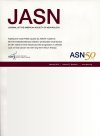Single-Cell Transcriptional Signatures of Glomerular Disease in Transgenic Mice with APOL1 Variants
Apolipoprotein L1 (APOL1)-G1 induced kidney disease in the two APOL1 transgenic mouse models, HIV-associated nephropathy and IFN-γ administration.Glomerular single-nuclear RNA-sequencing identified genes differentially expressed among mice with APOL1-G1 and G0 variants at single-cell resolution.
Background
Apolipoprotein L1 (APOL1) high-risk variants contribute to kidney disease among individuals with African ancestry. We sought to describe cell-specific APOL1 variant–induced pathways using two mouse models.
Methods
We characterized bacterial artificial chromosome/APOL1 transgenic mice crossed with HIV-associated nephropathy (HIVAN) Tg26 mice and bacterial artificial chromosome/APOL1 transgenic mice given IFN-γ.
Results
Both mouse models showed more severe glomerular disease in APOL1-G1 compared with APOL1-G0 mice. Synergistic podocyte-damaging pathways activated by APOL1-G1 and by the HIV transgene were identified by glomerular bulk RNA sequencing (RNA-seq) of HIVAN model. Single-nuclear RNA-seq revealed podocyte-specific patterns of differentially expressed genes as a function of APOL1 alleles. Shared activated pathways, for example, mammalian target of rapamycin, and differentially expressed genes, for example, Ccn2, in podocytes in both models suggest novel markers of APOL1-associated kidney disease. HIVAN mouse-model podocyte single-nuclear RNA-seq data showed similarity to human focal segmental glomerulosclerosis glomerular RNA-seq data. Differential effects of the APOL1-G1 variant on the eukaryotic initiation factor 2 pathway highlighted differences between the two models.
Conclusions
These findings in two mouse models demonstrated both shared and distinct cell type–specific transcriptomic signatures induced by APOL1 variants. These findings suggest novel therapeutic opportunities for APOL1 glomerulopathies.




